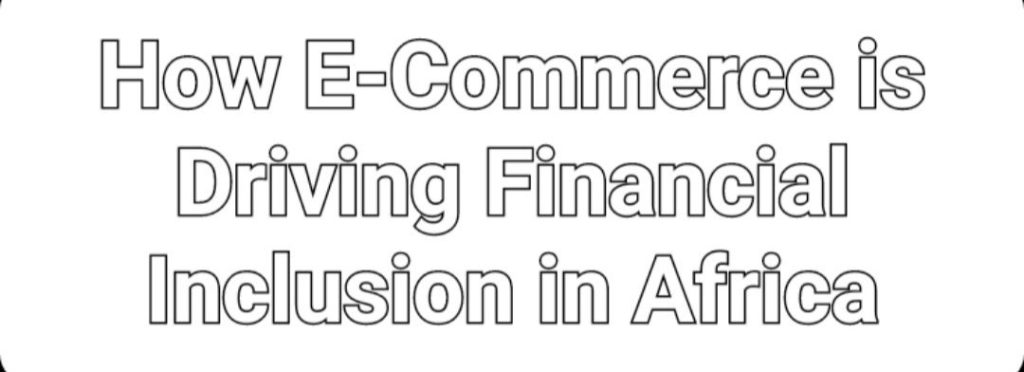How E-Commerce is Driving Financial Inclusion in Africa
In recent years, Africa has emerged as a hotbed of innovation and growth in the digital economy. One of the most transformative developments has been the rise of e-commerce, which is not only reshaping how people shop but also playing a pivotal role in driving financial inclusion across the continent. With a young, tech-savvy population and increasing internet penetration, e-commerce platforms are bridging the gap between the unbanked and formal financial systems, unlocking economic opportunities for millions.

The State of Financial Inclusion in Africa
Financial inclusion remains a significant challenge in Africa. According to the World Bank, nearly 350 million adults in sub-Saharan Africa lack access to formal financial services. Traditional banking infrastructure is often inaccessible in rural areas, and many people lack the documentation or credit history required to open bank accounts. This exclusion limits their ability to save, borrow, and invest, perpetuating cycles of poverty and inequality.
However, the rapid adoption of mobile technology has opened new doors. Mobile money services like M-Pesa in Kenya have already demonstrated the potential of digital financial solutions. Now, e-commerce is building on this foundation, creating a ripple effect that extends financial access to even more people.
E-Commerce as a Catalyst for Financial Inclusion
E-commerce platforms are uniquely positioned to drive financial inclusion in Africa. Here’s how:
1. Digital Payments as a Gateway
E-commerce relies on digital payments, which are often more accessible than traditional banking. Platforms like Jumia, Konga, and Takealot integrate mobile money and other digital payment options, allowing users without bank accounts to participate in the digital economy. By normalizing digital transactions, e-commerce is encouraging more people to adopt financial tools that were previously out of reach.
2. Access to Credit and Microfinance
Many e-commerce platforms are partnering with fintech companies to offer credit and microfinance solutions to their users. For example, sellers on platforms like Jumia can access working capital loans based on their sales performance. This access to credit empowers small businesses and entrepreneurs, enabling them to grow and contribute to the local economy.
3. Financial Literacy and Inclusion
E-commerce platforms are also playing an educational role. By introducing users to digital wallets, payment systems, and online transactions, they are helping to build financial literacy. This knowledge is critical for fostering trust in digital financial systems and encouraging long-term adoption.
4. Empowering Women and Rural Communities
E-commerce is breaking down barriers for marginalized groups, particularly women and rural communities. In many African countries, women face cultural and societal barriers to accessing financial services. E-commerce platforms provide them with opportunities to start businesses, sell products, and earn income independently. Similarly, rural entrepreneurs can now reach customers beyond their immediate geographic area, thanks to online marketplaces.
5. Job Creation and Economic Growth
The growth of e-commerce is creating jobs in logistics, customer service, and digital marketing, among other fields. These opportunities often come with access to digital payment systems, further integrating individuals into the formal economy. As more people gain employment and income through e-commerce, the demand for financial services continues to grow.
Success Stories Across the Continent
Several African countries are already reaping the benefits of e-commerce-driven financial inclusion:
- Kenya: With its robust mobile money ecosystem, Kenya has seen e-commerce platforms seamlessly integrate digital payments, enabling even small-scale farmers to sell their produce online.
- Nigeria: As Africa’s largest economy, Nigeria has witnessed a surge in e-commerce adoption, with platforms like Jumia and Paystack facilitating millions of transactions annually.
- South Africa: E-commerce giants like Takealot are driving financial inclusion by offering flexible payment options, including buy-now-pay-later services, to underserved communities.
Challenges and the Road Ahead
While the potential of e-commerce to drive financial inclusion is immense, challenges remain. Limited internet access in rural areas, high data costs, and a lack of trust in digital systems can hinder progress. Additionally, regulatory frameworks need to evolve to support the growth of e-commerce and fintech innovations.
To overcome these barriers, collaboration between governments, private sector players, and NGOs is essential. Investments in digital infrastructure, affordable internet access, and financial education will be critical to ensuring that the benefits of e-commerce reach all corners of the continent.
Conclusion
E-commerce is more than just a convenience—it’s a powerful tool for driving financial inclusion in Africa. By leveraging digital payments, expanding access to credit, and empowering marginalized groups, e-commerce platforms are transforming the economic landscape of the continent. As technology continues to evolve, the potential for e-commerce to bridge the financial inclusion gap will only grow, paving the way for a more inclusive and prosperous Africa.
The future of Africa’s economy is digital, and e-commerce is at the forefront of this revolution. By embracing this transformation, we can unlock opportunities for millions and build a more equitable financial system for all.
![IMG_20250311_024658_904[1] How E-Commerce is Driving Financial Inclusion in Africa](https://www.saalime.com/wp-content/uploads/2025/03/IMG_20250311_024658_9041.jpg)